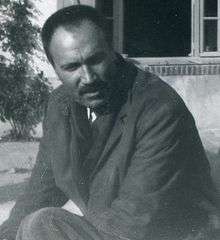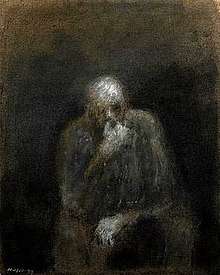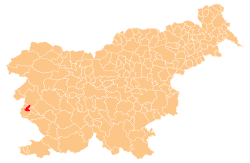Zoran Mušič
Zoran Mušič (12 February 1909 – 25 May 2005), baptised as Anton Zoran Musič, was a Slovene painter, printmaker, and draughtsman from the Karst Plateau near the Adriatic Sea. He was the only painter of Slovene descent who managed to establish himself in the elite cultural circles of Italy and France, particularly Paris, where he lived for most of his later life. He painted landscapes, still lifes, portraits, and self-portraits, as well as scenes of horror from the Dachau concentration camp and vedute of Venice.
Zoran Mušič | |
|---|---|
 Zoran Mušič in the 1960s | |
| Born | Anton Zoran 12 February 1909[1] Bukovica, Austria-Hungary (now in Slovenia) |
| Died | 25 May 2005 (aged 96)[1] Venice, Italy[1] |
| Nationality | Slovenian |
| Education | Academy of Fine Arts Zagreb |
| Known for | painting, drawing, printmaking[2] |
Notable work | Konjički (Little Horses), Dalmatian, Sienese, Umbrian Landscape, Nismo poslednji (We are not the last), Cathedrals, Self-portraits |
| Movement | Neodvisni, Ecole de Paris |
| Spouse(s) | Ida Cadorin Ida Barbarigo |
| Awards | Grand Prize Venice Biennale (1956) Prešeren Award (1991)[3] |

Life
Zoran Mušič was born in a Slovene-speaking family in Bukovica, a village in the Vipava Valley near Gorizia, in what was then the Austrian County of Gorizia and Gradisca (now in Slovenia). Mušič's father Anton was the headmaster of the local school, and his mother Marija (née Blažič) was a teacher there. Both parents were Slovenes from the Goriška region: his father was from the village of Šmartno in the Gorizia Hills, and his mother was born in the hamlet of Kostanjevica in the village of Lig.[4]
Mušič's father was mobilized and served on various battlefields during the First World War. In 1915, during the Battles of the Isonzo, the family (his mother with two children) was forced to flee to Arnače, a village near Velenje in the Duchy of Styria, where Zoran attended elementary school. In the spring of 1918, toward the end of World War I, the family moved back to Gorizia, but they were expelled again in late August 1919 by the Italian authorities, which had occupied the region. They moved to Griffen in Carinthia, but were expelled once again by the Austrian authorities after the Carinthian Plebiscite in late October 1920. They finally settled in Lower Styria, then part of the Kingdom of Serbs, Croats and Slovenes.[4]
Mušič attended two high schools in Maribor till 1928. After, he visited Vienna for a short time. Between 1930 and 1935 he continued his studies at the Academy of Fine Arts in Zagreb. Mušič spoke Slovene, German, Croatian, Italian, French and some Friulian.[5]
After graduation in 1934, he travelled extensively. He spent three months (April to June 1935) in Spain, mainly Madrid. Later he served his obligatory army service in Bileća (1936) in Yugoslavia. He spent each summer in Dalmatia while being based in Maribor and nearest village Hoče. In 1940, he moved to Ljubljana permanently. During this period (1942), he painted in two churches in his native Goriška region, together with his friend Avgust Černigoj (Drežnica, Grahovo) and one in village Gradno with another Slovenian painter Lojze Spacal.[4] In October 1943, he moved to Trieste and later for the first time to Venice. He had his first one-man show (outside Yugoslavia) in Trieste and several months later in Venice. In early October 1944, he was arrested by the Nazi German forces because he was in a group of Slovene anti-fascists. The group had hidden transmitter and was connected with British IS. His drawing and painting in Venice raised suspicions that he was a spy, and a month later he was sent to Dachau concentration camp, where he made more than 180 sketches of life in the camp, some under extremely difficult circumstances. From the drawings, mainly executed in May 1945, he managed to save around one hundred (some more with his friends). After liberation by Americans in April 29, 1945, Mušič returned to his hometown Ljubljana in early June. There, he was sent to a hospital (Golnik). A month later he was subjected to the pressures by the newly established Communist regime and moved to Gorizia at the end of July 1945. In the following months he travelled in the area of Trieste and Istria, spending some time in Pinguente (Buzet). In October 1945 he settled in Venice with the help of family Cadorin. In September 1949 he married younger painter Ida Cadorin - Barbarigo there.[4] He also painted a room in Vila Dornacher near Zuerich at the same period.
In 1950 he prepared huge tapestry: Marco Polo and his way to China for the passenger ship Augustus. At the same time he won the Gualino prize and in 1956 the Grand Prize for his printmaking at the Venice Biennale. In 1951 he was awarded the Prix de Paris, (jointly with Antonio Corpora in 1951) for his colorful paintings of Dalmatia. After 1952 he lived mainly in Paris, where the 'lyrical abstraction' of the French Informel determined the art world. Throughout this period he kept his studio in Venice and exhibited again at the Biennale in 1960, when he was awarded the UNESCO Prize. The much acclaimed series We Are Not the Last, in which the artist transformed the terror of his experiences in the concentration camp into documents of universal tragedy, was made in the 1970s.[4] His last achievement were series of Selfportratis and Double portraits. He had problems with his eyesight. Partly blind he signed his last drawings in the year 2000.
In 1981 Mušič was appointed Commandeur des Arts et des Lettres in Paris. Mušič's work has been honoured in numerous international exhibitions, such as the large retrospective exhibition at the Grand Palais in Paris in 1995, opened by the French and Slovenian presidents François Mitterrand and Milan Kučan.[4] At the same time Austrians promised him a permanent exhibition in Klagenfurt. It was never established. A huge part of his works was taken from his studio and never returned to the painter or his wife.
In 1991, Mušič was given the Prešeren Award for lifetime achievement, the highest decoration in the field of the arts in Slovenia.[3] Some of Mušič's works have been featured at Piran Coastal Galleries.[6] Gallery Zala from Ljubljana prepared 7 exhibitions (4 in Ljubljana, one in: Belgrade, Vienna and London). A big retrospective was prepared in Modern Gallery from Ljubljana in November 2009. Academy of Sciences from Slovenia published a monograph, written by 20 authors from Slovenia, Croatia, Austria, Italy and France (Vizije Zorana Mušiča) November 2012. First permanent exhibition of his prints was open in Dobrovo in 1991. Only permanent exhibition of his different works (paintings, prints, drawings) was open in National Gallery in Ljubljana in 2016. Bigger temporary exhibition of selected works was prepared in Lugano, Collezione Braglia in October 2016. Another exhibition was in Venice at Fortuny Museum in spring 2018: A Tribute to Zoran Music, The Zurich Room. The Leopold Museum in Vienna opened a bigger retrospective exhibition in April 2018 with 167 selected works.
He died in Venice in 2005 at the age of 96. He is buried in the local St. Michele cemetery.[4]
Exhibitions (selection)
- 1942: Zoran Mušič. Galerija Obersnel, Ljubljana, (February)
- 1944: Zoran Music. 25 oeuvres exposées. Piccola Galleria, Venice (June 17 - July 8)
- 1960: Music. Peintures et gouaches. Galerie_de_France, Paris (February 26 - March 20)
- 1964: Music. Zeichnungen und Graphik. Kunstmuseum Basel (May 9 - June 14)
- 1967: Zoran Anton Music. Retrospektivna razstava. Moderna Galerija, Ljubljana (April 14 - May 7)
- 1978: Music, le temps d'une mémoire. Rétrospective: Toiles - Aquarelles - Gouaches - Dessins de 1951 à 1977. Galerie de France, Paris (April 4 - May 20)
- 1992-93: Music, Arbeiten auf Papier von 1945 bis 1992. Graphische Sammlung Albertina, Vienna (November 25 - January 31)
- 1995: Zoran Music. Galeries nationales du Grand Palais, Paris (April 4 - Juli 3)
- 1995: Zoran Music. Nous ne sommes pas les derniers, Peintures, Dessins, Gravures. Musée des Beaux-Arts de Caen, Caen (May 18 - August 16)
- 1995-96: Zoran Music: Die späten Jahre. Bayerische Akademie der Schönen Künste, Munich (November 24 - January 14)
- 1997: Zoran Music. Schirn Kunsthalle Frankfurt, Frankfurt Main (April 24 - June 29)
- 1997: Zoran Music. MMG Gallery, Tokyo (August)
- 1998: Zoran Music: gli acquerelli veneziani 1947-1949. Museo Morandi - Instituzione Galleria d'Arte Moderna, Bologna (January 22 - April 13)
- 2006: Music in Slovene private Collections (1935 - 1997). Galerija Zala, Ljubljana (November 24 - December 22)
- 2009: A Spanish vision, February. National Gallery of Slovenia, Ljubljana (12. February - March)
- 2009: Zoran Mušič in private and public collections, November 2009 - February 2010. Modern Gallery of Slovenia, Ljubljana
- 2009: Zoran Mušič v slovenskih zasebnih zbirkah III. Galerija Zala, Ljubljana (February)
- 2016: Zoran Mušič, Permanent collection. National Gallery of Slovenia, Ljubljana
- 2018: Omaggio a Zoran Music. La Stanza di Zurigo. Museo Fortuny, Venezia Febbraio)
- 2018: Zoran Music. Poesie der Stille. Leopold Museum, Vienna (April 13 - August 06)
- 2019: Zoran Music. Gallery W&K - Wienerroihter & Kohlbacher, Vienna (May 22 - September 13)
- 2019: Music in Slovene private Collections VII. Galerija Zala, Ljubljana (June 6 - June 25)
- 2019: Zoran Mušič. Galerija in antikvitete Novak, Ljubljana (October 24 - November 9)
- 2020: Zoran Mušič. "The fascination of painting". Klagenfurt, (January 23 - March 1)
- 2020: Zoran Mušič.111 catalogues for the 111 Anniversary. National Gallery, Ljubljana. (February 11 - May 30)
- 2020: Zoran Mušič. "Drawings from Dachau," Modern Gallery, Ljubljana. (February 27 - July 1)
Museums and galleries
Austria
- Albertina, Vienna
- Essl Museum - Contemporary Art, Klosterneuburg/Vienna
- StadtGalerie, Klagenfurt, Klagenfurt
- Gallery Magnet, Völkermarkt/Carinthia
Chile
- Museo de la Solidaridad Salvador Allende, Santiago de Chile
Croatia
France
- Musée des Beaux-Arts, Caen
- Musée National d'Art Moderne, Paris
- Musée National du Louvre, Paris, prints
- Centre National Georges Pompidou, Paris, 10 drawings from Dachau
- Musée Malraux, Le Havre
- Musée de Valence, Valence
Germany
- Museum Abteiberg, Mönchengladbach
- Museum Folkwang, Essen
- Neue Pinakothek, München
Italy
- Galleria d´Arte Moderna, Bologna
- Galleria internazionale d'Arte Moderna Ca' Pesaro, Venice
- Museo Fortuny, Venice
- Galleria Nazionale, Roma, tapestry
- GaMeC galleria, Bergamo, painting
- Musei Provinciali di Gorizia, Gorizia, paintings
- Museo Morandi, Bologna
- Musei Civici, Treviso
- Museo Revoltella, Trieste, 24 drawings from Dachau
- MAGI '900- Museum of Artistic and Historical Excellence, Pieve di Cento (BO)
- Yad Vashem museum, Jerusalem
- Stedelijk Museum, Amsterdam
Slovenia
- Goriški muzej Kromberk, Galerija Zorana Mušiča, Dobrovo, Permanent exhibition: prints
- Pilonova galerija, Ajdovščina
- Mestni muzej Ljubljana, Ljubljana
- Moderna galerija Ljubljana, Ljubljana, drawings, prints, paintings
- Muzej novejše zgodovine Slovenije, Ljubljana
- National Gallery of Slovenia, Ljubljana, Permanent exhibition: paintings, sketches, prints
- Umetnostna galerija Maribor, Maribor
- Belokranjski muzej, Zbirka Kambič, Metlika, part of Permanent exhibition in Gallery Kambič
- Koroška galerija likovnih umetnosti, Slovenj Gradec
Spain
- Museo Thyssen-Bornemisza, Madrid
- Collecio IVAM, Valencia
Sweden
- Museum, Stockholm
Switzerland
- Kunstmuseum, Basel
- Fondazione Braglia, Lugano
- Musée Jenisch, Vevey
United Kingdom
- Estorick Collection, London
- Tate Modern, London
United States
- Art Institute of Chicago
- Carnegie Museum of Art, Pittsburgh
- Cleveland Museum of Art
- Dallas Museum of Art
- Fine Arts Museums of San Francisco
- List Visual Arts Center, Massachusetts Institute of Technology, Cambridge, Mass.
- Metropolitan Museum of Art, New York
- Museum of Modern Art, New York
- Philadelphia Museum of Art
Vatican
- Vatican Museums, Collection of Contemporary Art
References
- Estorick, Michael (28 June 2005). "Zoran Mušič". The Independent. Retrieved 25 August 2011.
- Clair, Jean. "Zoran Music". Grove Art Online. Tate.
- "Prešernove nagrade" (PDF) (in Slovenian). Ministry of Culture of the Republic of Slovenia. p. 13. Archived from the original (PDF) on 2011-07-17.
ZORAN MUŠIČ za življenjsko delo (slikar)
- G. Zupan, Biography, Videnja Zorana Mušiča, Ljubljana, 2012.
- BBC Radio 4 - Great Lives, Series 36, Kulvinder Ghir on Zoran Mušič. Tuesday 21 April 2015, 16:30. <http://www.bbc.co.uk/programmes/b05r3w3s>.
- Obalne galerije Piran - Arhivi - ZORAN MUŠIČ | 1909 - 2005 | Slike, gvaši, risbe
Further reading
- Dal Bon, Giovanna (2009). Double Portrait: Zoran Music - Ida Barbarigo. Johan & Levi Editore. ISBN 978-88-6010-045-0.
- Zoran KRŽIŠNIK, Tomaž BREJC, Ješa DENEGRI, Meta GABRŠEK PROSENC, Miklavž KOMELJ, Ivana SIMONOVIĆ ČELIĆ, Gojko ZUPAN, Jana INTIHAR FERJAN, Breda ILICH KLANČNIK, ZORAN MUŠIČ, V javnih in zasebnih zbirkah v Sloveniji, Moderna galerija Ljubljana, Ljubljana, 24. November 2009
- Nelida Silič NEMEC, Nace ŠUMI, Zoran KRŽIŠNIK, Galerija Zorana Mušiča, Grad Dobrovo, Stalna zbirka grafičnih del Zorana Mušiča, Goriški muzej, Nova Gorica, 1991.
- Ziva AMISHAI_MAISELS, Depiction and Interpretation, Pergamon Press, Oxford, New York, Seoul, Tokyo, 1993.
- Zoran Music, Galeries nationales du Grand Palais, Catalogue, Paris, 1995.
- Gojko ZUPAN, Zorenje Zorana Mušiča med 1909 in 1935, offprint, Ljubljana, 2006.
- Gojko ZUPAN, Umetnik na tujem : Zoran Mušič - slovenski izseljenec, Mohorjev koledar, Ljubljana, 2006. str. 177-182.
- Gojko ZUPAN, Zoran Mušič, Iz slovenskih privatnih zbirk II, Grafika (1931-1984), Ljubljana, 2008.
- Gojko ZUPAN, Life and Work, Zoran Mušič, catalogue, Moderna galerija Ljubljana, 2009.
- Gojko ZUPAN, Dachauske risbe Zorana Mušiča, Zbornik za Staneta Bernika, Ljubljana, 2009. str. 274-301.
- Lydia Harambourg, Dictionnaire des peintres de l'École de Paris, 1945-1965, Éditions Ides et Calendes, Neuchâtel, 1993 (ISBN 2825800481); nouvelle édition, 2010, p. 39, 355-358 (ISBN 978-2-8258-0241-0)
- Gojko ZUPAN, Biography, Videnja Zorana Mušiča, SAZU, Ljubljana, 2012.
- Jean CLAIR, Vanda MUŠIČ, Gojko ZUPAN, Zoran MUŠIČ, From Ljuban, Milada and Vanda Mušič Collection, National Gallery, Ljubljana, 2016. English Edition, ISBN 978-961-6743-54-9
- Zoran Music, Boualem Sansal, Pascal Bruckner, Michael Prazan, Skira, Applicat-Prazan, 2016. ISBN 978-2-37074-032-8
- Hans-Peter WIPPLINGER, Ivan RISTIĆ, Gojko ZUPAN, Jean CLAIR, Marilena PASQUALI, Zoran Mušič : Poesie der Stille = poetry of silence : [Leopold Museum, Wien, 13. April bis 6. August 2018] ISBN 978-3-9504518-1-8
- Gojko ZUPAN, Zoran Mušič, Iz slovenskih privatnih zbirk VII / Music in Slovene private collections VII,, Ljubljana, 2019.
External links
| Wikimedia Commons has media related to Zoran Mušič. |
- A tribute to Zoran Music with photos and recent exhibitions
- Zoran Mušič web page
- Zoran Mušič biography on Widewalls
- Great works: Self-Portrait 1990 (48x38 cms (sic)), Zoran Music - Michael Glover, The Independent
- Venice Pays Homage to Zoran Music with Exhibition at Palazzo Franchetti - artdaily.org
- A life of wandering - Andrew Lambirth, The Spectator, 29 July 2000
